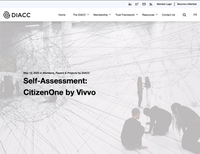We're serious about privacy.
And so is our software. Respecting the right to privacy is a core value of our company.
Value of Privacy
Privacy has very real value – in both dollars and sense.
$16B
Dollars CAD
$236
Dollars CAD
$5.58M
Dollars CAD
We’re bringing privacy-focused technology to Canada’s emerging, digital economy.
Vivvo is a proud member of Digital ID & Authentication Council of Canada (DIACC), a non-profit coalition of private and public sector leaders working to:
- Enable Canada’s full, secure, and beneficial global digital economy participation.
- Advance Canada’s digital economy agenda which depends on digital identity that is ubiquitous, trustworthy, convenient, and private.
- Equip consumers and businesses with tools for services online, on the phone, and in person.
- Unlock digital ID service capabilities of the public and private sectors.
“We’re sitting on a pile of data.”
Does that phrase make you feel excited about the opportunities or terrified at the risks?
Whether that pile of data is a treasure trove or a tinder box has a lot to do with how you manage it.
Our platform can help.
Make data an asset, not a liability.
Moving to an increasingly digitally-driven mix of customer interactions presents both considerable opportunity and risk for organizations. The benefits of leveraging technology and automation are clear however there are accompanying risks that need to be actively managed.
One of the consequences of digital business is the accumulation of personal, private data. This comes in the context of increasing regulatory stringency as well as heightened consumer expectations of how their data is managed. Organizations need a solution that enables them to mitigate these emerging risks and fulfill their obligations to data owners. The ability to collect and maintain ongoing consent from data owners requires particular attention.
Business
Mitigate business risk regarding data privacy and consent
Moving to an increasingly digitally-driven mix of customer interactions presents both considerable opportunity and risk for organizations. The benefits of leveraging technology and automation are clear however there are accompanying risks that need to be actively managed.
One of the consequences of digital business is the accumulation of personal, private data. This comes in the context of increasing regulatory stringency as well as heightened consumer expectations of how their data is managed. Organizations need a solution that enables them to mitigate these emerging risks and fulfill their obligations to data owners. The ability to collect and maintain ongoing consent from data owners requires particular attention.
BEFORE
Inconsistent implementation of privacy governance creating business risk
AFTER
Enterprise-wide alignment to privacy policy and quality management program
Technology
Accelerate integration with legacy and proprietary systems
Many technology systems in operation today were conceived of long before the realities of today’s business environment were imagined. These legacy systems are still getting used to the idea of being a team player. This makes the basics of integration alone challenging, not to mention aligning an entire enterprise architecture with principles of privacy and trust challenging.
These dated architectures present significant barriers to business trying to achieve an integrated environment for managing data integration, not to mention the privacy and consent layer of digital services
BEFORE
Protracted timelines and cost overruns from integrating with legacy and proprietary systems
AFTER
Maximized investments, faster implementation and standards-based interoperability
Customer Experience
Empower customers with a consistent user experience
Customer expectations are simple. Make it fast, easy and memorable.
Regardless of the sector you operate in, your customers are engaging with you fresh from the best user experiences Silicon Valley or Seattle has to offer. While these standards aren’t easy to compete with, they can’t be ignored, even by public sector organizations that have long been able to define the rules of engagement with their public.
There is good news. When improvements are made, the benefits are mutual for customers and the business. Most friction points that customers experience point to internal opportunities that can be addressed with customer-centric service design and modern technology architectures.
BEFORE
Inconsistent customer experience that reflects internal siloes and legacy implementations
AFTER
Consistent sign-on and user experience with transparent consent

